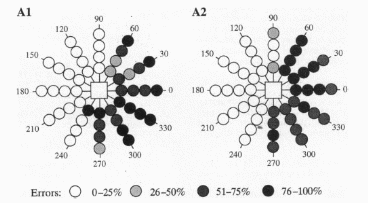Research Question/Implications of Study
The main research question is centered around understanding and revealing major aspects of parallels between monkeys with striate lesions and humans with blindsight, where the emphasis is put on residual vision capabilities of the subjects under two different conditions for stimuli delivery as well as response-related details in terms of saccades. In other words, the researchers wanted to know whether or not monkeys with striate lesions exhibit similar residual vision abilities as people with blindsight. The implications are that by correctly setting the conditions for the stimuli delivery and responses correctly, it is possible to enable a higher degree of utilization of these residual vision capabilities among the target groups, such as standard conditions and forced-choice conditions (Moore et al., 1995). The study reveals major details in regards to unique functional features of blindsight by replicating the condition in monkey subjects and testing the accuracy of target recognition.
The findings are indicative of the fact that monkeys with striate lesions under standard conditions, where the target stimuli were delivered without the removal of the fixation point, did not move their eyes or saccade to the target. Under the forced-choice conditions, where the fixation point target was removed as soon as the target stimuli were delivered, the subjects moved their eyes towards the new target. In other words, the unconscious residual vision is present, but there is no capability to distinguish between the fixation target or stimuli targets. In addition, ipsilateral residual vision, which means vision on the same side where the striate lesion is, was far more responsive than contralateral one, which means the visual field opposite to the striate lesions (Moore et al., 1995). This implies that there is a difference between visual responsiveness on the basis of visual field sides, but the key takeaway is that the removal of the old fixation point and subsequent addition of new stimuli is sufficient to ensure a saccade or response among monkeys with striate lesions and people with blindsight.
Experiment & Methodology
The experiment was a head-restrained primate chair, where both monkeys with striate lesions were trained to fixate on the central point. The correct saccades to the stimuli were rewarded with juices, and errors were either resulting in delayed rewards or no rewards depending on the experimental conditions. There were two conditions under which experiments were conducted, such as standard and forced-choice settings (Moore et al., 1995). In the case of the former, the fixation point was always present, whereas the stimuli target points were delivered or presented randomly alongside the fixation point. In the case of the forced-choice condition, the fixation point was removed alongside the appearance of the stimuli target points.
In simple terms, the subjects were exposed to visual stimuli with and without the fixation point removal. The new visual stimuli induced reaction is the previous fixation target was removed. It proves that blindsight is reactive to changes in stimuli, but unreactive if there is a static fixation point. Therefore, the result is that blindsight monkeys can “see” objects on the same side of the lesion. In addition, the reaction is stronger if the initial fixation point is removed.
The assessment of visual field angle differences was also measured on the basis of ipsilateral and contralateral sides to the striate lesions. For example, in Figure 1 below, one can observe the rate of errors made by both monkeys A1 and A2 in regards to recognition of the stimuli through saccades. Both monkeys show a higher rate of errors on the contralateral side but significantly fewer errors on the ipsilateral side (Moore et al., 1995). Although there are differences in visual field regional response rates and there are also fixation point removal dependencies, the residual vision weakness is that it needs to lose the initially locked point to be able to switch to the next point or target of interest.

Reference
Moore, T., Rodman, H. R., Repp, A. B., & Gross, C. G. (1995). Localization of visual stimuli after striate cortex damage in monkeys: Parallels with human blindsight. Proceedings of the National Academy of Sciences of the United States of America, 92, 8215-8218.